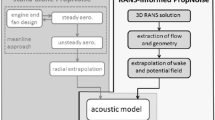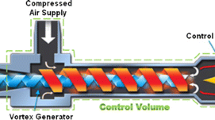Abstract
This paper describes a detailed flutter analysis of fan casing contour modifications on a scaled high-speed fan to investigate the influence and effect on flutter boundaries. The flutter analysis focusses on discrete selected members from a previous multidisciplinary study of an automated aero-acoustic optimization with respect to the overall engine performance. The aerodynamic baseline performance of the high-bypass ratio fan is validated with measured rig data using Reynolds-averaged Navier–Stokes (RANS) CFD simulations. Flutter stability predictions are based on the energy method in traveling wave and influence the coefficient formulation using a multi-passage fan assembly in a wide engine operating range. Transonic stall flutter occurs for the first bending mode of blade vibration at part speed, where a few design members show an increased stabilizing aeroelastic behavior especially at approach flight condition. In contrast to that, the results indicate a destabilizing flutter stability effect for certain casing designs at cruise speed related to higher mass flows near choke, which is identified as a transonic unstalled flutter type. Aerodynamic key parameters for the flutter onset mechanism have proved to be the shock/boundary layer interactions in tip region of the fan suction side, which leads to flow separation. A second mechanism is driven by the additional blade vibration in combination with the interaction of shock and tip clearance flow as well as the incoming flow.















Similar content being viewed by others
Abbreviations
- BBN:
-
Broad band noise
- CFD:
-
Computational fluid dynamic
- DLR:
-
Deutsches Zentrum für Luft- und Raumfahrt (German Aerospace Center)
- DP:
-
Design point (cruise speed)
- FEM:
-
Finite element method
- FM:
-
Flutter margin
- FN:
-
Net thrust
- FSI:
-
Fluid–structure interaction
- IC:
-
Influence coefficient
- ND:
-
Nodal diameter
- PBC:
-
Periodic boundary condition
- PE:
-
Peak efficiency
- PSBC:
-
Phase-shifted boundary condition
- RANS:
-
Reynolds-averaged Navier–Stokes
- SA:
-
Spalart–Allmaras
- SFC:
-
Specific fuel consumption
- TET:
-
Turbine entry temperature
- TON:
-
Tonal noise
- TWM:
-
Traveling wave mode
- UFFA:
-
Universal fan facility for acoustics
- \(\varLambda \) :
-
Logarithmic decrement
- \(\varPi \) :
-
Total pressure ratio
- \(\varPi ^{*}\) :
-
\(\varPi \)/\(\varPi _{PE}\) at design speed
- \(\sigma \) :
-
Inter-blade phase angle
- \(\dot{\mathbf{x }}\) :
-
Blade velocity
- \(\dot{m}_{\text{ red }}\) :
-
Reduced massflow
- \(A_{0}\) :
-
Blade surface
- \(c_\text {w}\) :
-
Influence coefficient
- \(E_{\text {kin}}\) :
-
Kinetic energy
- \(Ma_{\text {rel}}\) :
-
Relative mach number
- \(N_{\text {B}}\) :
-
Blade count
- \(p_{\text {dyn}}\) :
-
Dynamic pressure
- \(q_{i}\) :
-
Vibration amplitude
- \(W_{\text {aero}}\) :
-
Aerodynamic work
- n :
-
Blade surface normal vector
- C:
-
Chord length
- f:
-
Vibration frequency
- p:
-
Static pressure
References
Vahdati, M., Simpson, G., Imregun, M.: Mechanisms for Wide-Chord Fan Blade Flutter. ASME J. Eng. Gas Turbines Power. 133(4), 041029 (2011)
Stapelfeldt, S., Vahdati M.: On the importance of engine-representative models for fan flutter predictions. ASME Paper No. GT2017-64167 (2017)
Srinivasan, A.V.: Flutter and resonant vibration characteristics of engine blades. ASME. J. Eng. Gas Turbines Power 119(4), 742–775 (1997)
Vahdati, M., Smith, N., Zhao, F.: Influence of intake on fan blade flutter. ASME. J. Turbomach. 137(8), 081002 (2015)
Zhao, F., Nipkau, J., Vahdati, M.: Influence of acoustic reflections on flutter stability of an embedded blade row. Proc. Inst. Mech. Eng. Part A-J. Power Energy 230, 29–43 (2016)
Lee, K., Wilson, M., Vahdati, M.: Numerical study on aeroelastic instability for a low-speed fan. ASME. J. Turbomach. 139(7), 071004 (2017)
Vahdati, M., Cumpsty, N.: aeroelastic instability in transonic fans. ASME. J. Eng. Gas Turbines Power 138(2), 022604 (2015)
Marshall, J.G., Imregun, M.: A review of aeroelasticity methods with emphasis on turbomachinery applications. J. Fluids Struct. 10, 237–267 (1996)
Aulich, A.-L., Sauer, T., Iseni, S., Moreau, A., Peitsch, D., Mailach, R., Micallef, D., Enghardt, L., Nicke, E.: Fan casing contouring under consideration of aeroacoustics, mechanics, aeroelasticity, and whole engine performance. CEAS Aeronaut. J. 8(19), 157–166 (2016)
Moreau, A., Aulich, A.-L., Jaron, R., Nicke, E., Enghardt L.: Optimization of casing contours in aero-engine fan stage with emphasis on rotor-stator interaction noise. ISROMAC Paper (2016)
Becker, K., Heitkamp, K., Kgeler, E.: Recent progress in a hybrid-grid CFD solver for turbomachinery flows. ECCOMAS CFD (2010)
Jaron, R., Moreau, A., Guérin, S.: Extrapolation of RANS flow data for improved analytical fan tone prediction. AIAA Paper No. AIAA-2015-2515 (2015)
Aulich, M., Vo, C., Raitor, T.: Optimization strategies demonstrated on a transonic centrifugal compressor. ISROMAC (2014)
Becker, R., Wolters, F., Nauroz, M., Otten, T.: Development of a gas turbine performance code and its application to preliminary engine design. DLRK Paper No. DLRK2011-241485 (2011)
Rosic, B., Denton, J.D., Pullan, G.: The importance of shroud leakage modeling in multistage turbine flow calculations. ASME J. Turbomach. 128, 699–707 (2006)
Micallef, D., Witteck, D., Wiedermann, A., Mailach, R.: An efficient workflow for accurate flutter stability analyses and application to a state of the art compressor rotor. ASME Paper No. GT2014-25646 (2014)
Iseni, S., Micallef, D., Mailach, R.: Investigation of inlet distortion on the flutter stability of a highly loaded transonic fan rotor. ASME Paper No. GT2016-56593 (2016)
Micallef, D., Witteck, D., Wiedermann, A., Kluß, D., Mailach, R. (2012): Three-dimensional viscous flutter analyses of a turbine cascade in subsonic and transonic flows. ASME Paper No. GT2012-68396 (2012)
Witteck, D., Micallef, D., Wiedermann, A., Mailach, R.: Three-dimensional viscous flutter analysis of a turbine cascade in supersonic flow. ISUAAAT13-S9-2, 13th International Symposium on Unsteady Aerodynamics, Aeroacoustics and Aeroelasticity of Turbomachines (2012)
Srivastava, R., Bakhle, M.A., Keith, T.G.: Numerical simulation of aerodynamic damping for flutter analysis of turbomachinery blade rows. J. Propuls. Power 19, 260–267 (2003)
Srivastava, R., Keith, T.G.: Influence of shock wave on turbomachinery blade row flutter. J. Propuls. Power 21, 167–174 (2005)
Carta, F.O.: Coupled blade-disk-shroud flutter instabilities in turbojet engine rotors. ASME J. Eng. Power 89, 419–426 (1967)
Schuff, M., Lengyel-Kampmann, T., Forsthofer, N.: Influence of the steady deformation on numerical flutter prediction for highly loaded and flexible fan blades. ASME Paper No. GT2017-64027 (2017)
Halliwell, D.G.: Fan supersonic flutter: prediction and test analysis. Reports and Memoranda No. 3789 (1975)
Acknowledgements
The authors are grateful to AneCom for providing the geometry and performance data of the UFFA-Fan and Dr. K. Liesner for his valuable input. The authors would also like to acknowledge the financial support of the industrial partner Rolls-Royce Deutschland and the German Federal Ministry of Economic Affairs and Energy in the frame of the Aeronautical Research Program LuFo (project FanTip, Grant Numbers 20E1304A, 20E1304B, 20E1304C). Numerical simulations were carried out on the High Performance Computing System Cheops at the University of Cologne.
Author information
Authors and Affiliations
Corresponding author
Rights and permissions
About this article
Cite this article
Iseni, S., Micallef, D., Engelmann, D. et al. Influence of casing contouring on flutter boundaries of a jet engine fan. CEAS Aeronaut J 10, 805–815 (2019). https://doi.org/10.1007/s13272-018-0351-y
Received:
Revised:
Accepted:
Published:
Issue Date:
DOI: https://doi.org/10.1007/s13272-018-0351-y




